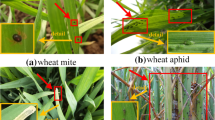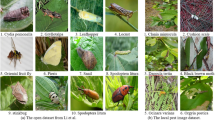Abstract
Camellia oil is one of the most healthy edible oils in the world. It has the effects of lowering blood pressure, reducing blood fat, and softening blood vessels. Whereas, the Camellia oleifera plant is easily infected by various pests and diseases in the process of growing, which limits the yield of Camellia oil. Thereupon, seeking an intelligent information tool to automatically detect Camellia oleifera pests is of great importance. Recent development in deep learning (DL)-based methods has provided promising performance in plant pest detection. However, to date, DL methods have been rarely applied in this field, except that some existing work focuses on it from public datasets. The main reasons behind the limited usage of DL models in Camellia pest detection include: a large number of training samples, which is difficult to collect, the complicated backdrops of experimental materials, which are not easy to train an efficient model, the low recognition accuracy, which is hard to apply in practical scenarios, and others. Therefore, this study proposes a novel network architecture, namely MAM-IncNet, to address these challenges. Referring to the cascaded structure of single shot multibox detector (SSD), we substitute the former convolutional layers of SSD with the optimized Inception modules (M-Inception), and the pre-trained VGG16 is utilized as the backbone network. Further, a hybrid attention mechanism including channel-wise and spatial attention is incorporated into the network to realize the maximum reuse of inter-channel relationships and spatial point characteristics. The proposed method has attained a recall rate of 81.44% for the detection of Camellia oleifera pests in practical field scenarios. Experimental findings demonstrate the efficacy and feasibility of the proposed method for the detection of Camellia oleifera insect pests.






Similar content being viewed by others
Data availability
Data will be made available on reasonable request.
References
Fina F, Birch P, Young R, Obu J, Faithpraise B, Chatwin C (2013) Automatic plant pest detection and recognition using k-means clustering algorithm and correspondence filters. Int J Adv Biotechnol Res 4(2):189–199
Kaya Y, Kayci L, Uyar M (2015) Automatic identification of butterfly species based on local binary patterns and artificial neural network. Appl Soft Comput 28:132–137
Wang J, Lin C, Ji L, Liang A (2012) A new automatic identification system of insect images at the order level. Knowl-Based Syst 33:102–110
Kang SH, Cho JH, Lee SH (2014) Identification of butterfly based on their shapes when viewed from different angles using an artificial neural network. J Asia-Pac Entomol 17(2):143–149
Ebrahimi MA, Khoshtaghaza MH, Minaei S, Jamshidi B (2017) Vision-based pest detection based on SVM classification method. Comput Electron Agric 137:52–58
Chen W, Chen J, Zeb A, Yang S, Zhang D (2022) Mobile convolution neural network for the recognition of potato leaf disease images. Multimed Tools Appl 81(15):20797–20816
Hssayni EH, Joudar NE, Ettaouil M (2022) Localization and reduction of redundancy in CNN using L 1-sparsity induction. J Ambient Intell Humaniz Comput 1–13
Ning X et al (2023) Hyper-sausage coverage function neuron model and learning algorithm for image classification. Pattern Recognit 136:109216
Tian S et al (2023) Continuous transfer of neural network representational similarity for incremental learning. Neurocomputing 545:126300
Joudar N-E, Ettaouil M (2022) An adaptive Drop method for deep neural networks regularization: estimation of DropConnect hyperparameter using generalization gap. Knowl-Based Syst 253:109567
Hssayni El H, Joudar N‐E, Ettaouil M (2022) A deep learning framework for time series classification using normal cloud representation and convolutional neural network optimization. Comput Intell 38(6):2056–2074
Ning X et al (2022) HCFNN: high-order coverage function neural network for image classification. Pattern Recognit 131:108873
Shijie J, Peiyi J, Siping H (2017) Automatic detection of tomato diseases and pests based on leaf images. In: 2017 Chinese automation congress (CAC), IEEE, pp 2537–2510
Liu Z, Gao J, Yang G, Zhang H, He Y (2016) Localization and classification of paddy field pests using a saliency map and deep convolutional neural network. Sci Rep 6(1):1–12
Thenmozhi K, Reddy US (2019) Crop pest classification based on deep convolutional neural network and transfer learning. Comput Electron Agric 164:104906
Fuentes A, Yoon S, Kim SC, Park DS (2017) A robust deep-learning-based detector for real-time tomato plant diseases and pests recognition. Sensors 17(9):2022
Lee SH, Lin SR, Chen SF (2020) Identification of tea foliar diseases and pest damage under practical field conditions using a convolutional neural network. Plant Pathol 69(9):1731–1739
Wang X, Liu J (2021) Tomato anomalies detection in greenhouse scenarios based on YOLO-Dense. Front Plant Sci 12:533
Szegedy C, Liu W, Jia Y, Sermanet P, Reed S, Anguelov D, ... Rabinovich A (2015) Going deeper with convolutions. In: Proceedings of the IEEE conference on computer vision and pattern recognition, pp 1–9
Chen L-C, Papandreou G, Schroff F, Adam H (2017) Rethinking atrous convolution for semantic image segmentation. arXiv: Computer Vision and Pattern Recognition
He K, Zhang X, Ren S, Sun J (2016) Deep residual learning for image recognition. In: Proceedings of the IEEE conference on computer vision and pattern recognition, pp 770–778
Szegedy C, Ioffe S, Vanhoucke V, Alemi A (2017) Inception-v4, inception-resnet and the impact of residual connections on learning. In: Proceedings of the AAAI conference on artificial intelligence (vol. 31, no. 1)
Hou Q, Zhou D, Feng J (2021) Coordinate attention for efficient mobile network design. In: Proceedings of the IEEE/CVF conference on computer vision and pattern recognition, pp 13713–13722
Tsotsos JK (2011) A computational perspective on visual attention. MIT Press
Huang Z, Wang X, Huang L, Huang C, Wei Y, Liu W (2019) Ccnet: Criss-cross attention for semantic segmentation. In: Proceedings of the IEEE/CVF international conference on computer vision, pp 603–612
Fu J, Liu J, Tian H, Li Y, Bao Y, Fang Z, Lu H (2019) Dual attention network for scene segmentation. In: Proceedings of the IEEE/CVF conference on computer vision and pattern recognition, pp 3146–3154
Hou Q, Zhang L, Cheng MM, Feng J (2020) Strip pooling: Rethinking spatial pooling for scene parsing. In: Proceedings of the IEEE/CVF conference on computer vision and pattern recognition, pp 4003–4012
Hu J, Shen L, Albanie S, Sun G, Vedaldi A (2018) Gather-excite: Exploiting feature context in convolutional neural networks. Advances in neural information processing systems, 31
Bello I, Zoph B, Vaswani A, Shlens J, Le QV (2019) Attention augmented convolutional networks. In: Proceedings of the IEEE/CVF international conference on computer vision, pp 3286–3295
Hu J, Shen L, Sun G (2018) Squeeze-and-excitation networks. In: Proceedings of the IEEE conference on computer vision and pattern recognition, pp 7132–7141
Woo S, Park J, Lee JY, Kweon IS (2018) Cbam: Convolutional block attention module. In: Proceedings of the European conference on computer vision (ECCV), pp 3–19
Liu W, Anguelov D, Erhan D, Szegedy C, Reed S, Fu CY, Berg AC (2016) Ssd: Single shot multibox detector. In: European conference on computer vision. Springer, Cham, pp 21–37
Zhao Z, Xu G, Qi Y, Liu N, Zhang T (2016) Multi-patch deep features for power line insulator status classification from aerial images. In: 2016 international joint conference on neural networks (IJCNN), IEEE, pp 3187–3194
Simonyan K, Zisserman A (2014) Very deep convolutional networks for large-scale image recognition. arXiv preprint arXiv:1409.1556
Russakovsky O, Deng J, Su H, Krause J, Satheesh S, MaS ... Fei-Fei L (2015) Imagenet large scale visual recognition challenge. Int J Comput Vision 115(3):211–252
Kingma DP, Ba JL (2015) Adam: A Method for Stochastic Optimization. In: ICLR 2015 : International conference on learning representations 2015
Younis A, Shixin L, Jn S, Hai Z (2020) Real-time object detection using pre-trained deep learning models MobileNet-SSD. In: Proceedings of 2020 the 6th international conference on computing and data engineering, pp 44–48
Redmon J, Farhadi A (2018) Yolov3: An incremental improvement. arXiv preprint arXiv:1804.02767
Ren S, He K, Girshick R, Sun J (2015) Faster r-cnn: towards real-time object detection with region proposal networks. Adv Neural Inf Process Syst 28:91–99
Liu S, Huang D (2018) Receptive field block net for accurate and fast object detection. In: Proceedings of the European conference on computer vision (ECCV), pp 385–400
Zhao Q, Sheng T, Wang Y, Tang Z, Chen Y, Cai L, Ling H (2019) M2det: A single-shot object detector based on multi-level feature pyramid network. In: Proceedings of the AAAI conference on artificial intelligence, vol 33, no 01, pp 9259–9266
Acknowledgements
The work is partially supported by the Research Funds for the project of Automatic identification and diagnosis of plant diseases and pests on mobile phones using big data techniques (Hunan Provincial Natural Science Research Fund). The authors are very grateful to the editors and anonymous reviewers for their constructive suggestions.
Author information
Authors and Affiliations
Corresponding author
Ethics declarations
Conflict of interest
The authors declare that they have no conflict of interest.
Additional information
Publisher's Note
Springer Nature remains neutral with regard to jurisdictional claims in published maps and institutional affiliations.
Rights and permissions
Springer Nature or its licensor (e.g. a society or other partner) holds exclusive rights to this article under a publishing agreement with the author(s) or other rightsholder(s); author self-archiving of the accepted manuscript version of this article is solely governed by the terms of such publishing agreement and applicable law.
About this article
Cite this article
Chen, J., Chen, W., Nanehkaran, Y.A. et al. MAM-IncNet: an end-to-end deep learning detector for Camellia pest recognition. Multimed Tools Appl 83, 31379–31394 (2024). https://doi.org/10.1007/s11042-023-16680-4
Received:
Revised:
Accepted:
Published:
Issue Date:
DOI: https://doi.org/10.1007/s11042-023-16680-4




